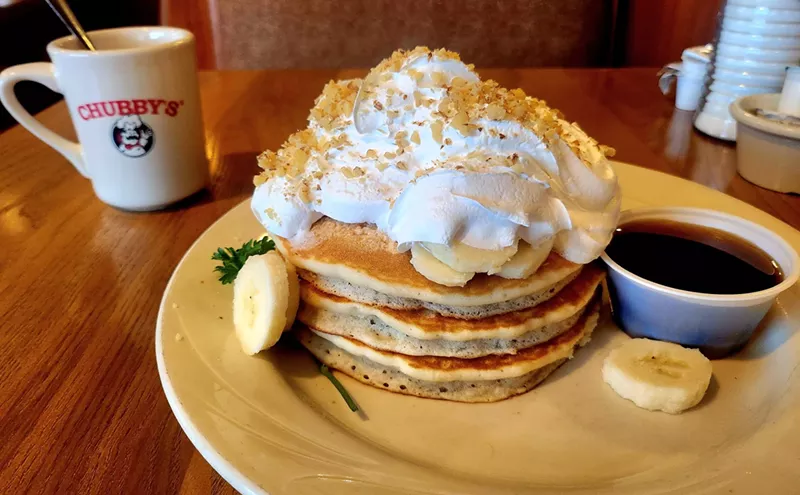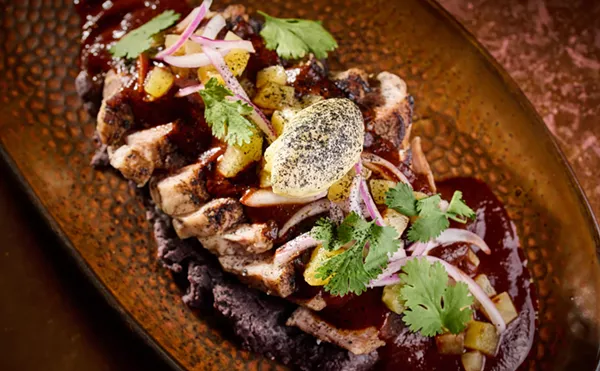Chicken-fried steak played a key role in President Bush's recent policy victories at the United Nations. Without the Texas delicacy, inspection teams would still be idle and Saddam Hussein, that old nemesis of the Bush family, would be doing whatever it is he does when he runs out of piano wire--presumably a little Kurd hunting.
Let's face it, our president is not a smart man. To place him in serious foreign-policy negotiations with experienced heads of state is akin to Homer Simpson accepting a faculty position at Northwestern or allowing Clarence Thomas to interpret the Constitution.
Yet the Bush family knows how to use food as a weapon. The former prez, remember, doused Japanese officials with regurgitated wasabi when discussions reached an impasse. So we figure George W. threatened to serve members of the U.N. Security Council a heaping plate of chicken-fried steak if they failed to support his foreign policy.
No one outside of Texas eats chicken-fried steak. Well, no one outside of Texas, Oklahoma and Arkansas. "They deep fry it so it can't be seen," speculates Jeff Molnar, an Ohio native. "They probably put it on a stick at the fair." Even the elder Bush recalls some uncertainty upon first encountering the state's native dish. Arriving in Texas for the first time after a long drive from his real home in the Northeast, he stopped at a roadside cafe. "I'll admit I didn't know if chicken-fried steak was a chicken fried like a steak or a steak that tasted like a chicken," he revealed during a 1989 speech in Austin.
Texans, on the other hand, love the stuff. "It's awesome," beams native Jenny Frederick. "With mashed potatoes and gravy, there's nothing better. That is a true Texas meal."
Admittedly, few members of the Burning Question crew trace their roots to this state, and we cringed when this question dropped through our mail slot. Shortly after opening the envelope, in fact, we suffered a rash of defections from the crew.
Yet for the benefit of the growing number of non-Texans in Dallas, we must ask why. Why inflict this gastronomic abomination on the rest of us?
"It took me a long time to realize that if you're not from Texas, you won't get it," says Roland Zamorano, manager at Good Eats on Oak Lawn Avenue. What's to get? Take an old leather belt or similar cut of meat, pummel it with a mallet, coat it with eggs, drench it in batter, fry it beyond recognition and bury it in a white gravy that closely resembles paste. "Believe it or not, there's a lot of factors," Zamorano explains. "The batter, the cut of meat, the cooking temperature. A lot of people make a mistake with grease, either too hot or too cool. There are a lot of different steps."
Of course, as Marc Cassel, executive chef at the Green Room points out, "You can fry a turd and it tastes good." Compared with some of the chicken-fried shoes we've been served, that doesn't sound so bad.
Aficionados of the dish admit that a poorly prepared chicken-fried steak resembles a plate of old tires rolled in flour. A good one, on the other hand, reaches a point of near perfection: crunchy not greasy on the outside, tender inside, spiced with peppered gravy. Sorta like Milk Bones dog biscuits, except for the gravy part. "It has to be really tenderized," says Cassel, who occasionally cooks up chicken-fried tenderloin for guests ordering his adventurous 'feed me' dinner. "You have to be able to cut it with a fork."
Traditional chicken-fried steak starts not with tenderloin, but with an inferior cut of beef. The tenderizing process slices the sinews, tendons and other unidentifiable clumps and flattens small pieces of meat into plate-filling monstrosities. Pioneers and ranchers in Texas probably adapted the recipe from Wiener schnitzel, using stringy beef in place of dachshund. Or veal. In the days before refrigeration, spices, gravy and a quick turn in the frying pan covered the taste of "aging" meat.
Once sopped in batter, the thin hunk of beef cooks quickly. We actually enjoyed the version served at Good Eats. If we ever suffer from a hangover (and you know, for a hangover to set in one must first stop drinking), the Burning Question crew will probably return to the Oak Lawn restaurant for another. Can't think of a better cure. Lucky's Café in North Dallas fries up a reasonably edible piece. We spent only a limited amount of time on the couch writhing in pain afterward. After forcing down a chicken-fried steak at Humperdink's, however, we contemplated home stomach surgery. One member of the crew even started to scrub his tongue with a Brillo pad to scrape off the aftertaste before severe cramping curtailed his efforts at self-mutilation.
In other words, it was not too good.
Despite the risk of ingesting an old tire, diners in Texas restaurants order more than 800,000 chicken-fried steaks every day, according to some estimates. At about 800 calories and 54 grams of fat per serving, that's 640,000,000 calories and 43,200,000 globs of fat dished out each day. In other words, the state's favorite dish adds about 183,000 pounds to our waistlines on a daily basis.
"I don't think of it that way," contends Rachel Cramer, a Texan. "I usually don't analyze my food."
OK, OK. So it's really no different than other regional oddities. They cook up some truly horrid things in Pennsylvania Dutch country. And the traditional traveler's lunch in the Southeast--a Moon Pie and an RC Cola--makes chicken-fried steak look almost appetizing. The attachment between Texans and a piece of inferior beef, mutilated and fried, just seems a bit odd. Even renowned chefs like Cassel succumb to the breaded beast.
"When I'm in the mood for it, nothing satisfies like a chicken-fried steak," he says. "It rules."
So, why not? That's our answer to this week's Burning Question, and we stand by it. Chicken-fried steak has origins in the early Euro-American settlements, where people altered familiar recipes to fit local conditions. It defied trends like tofu, nouvelle cuisine and Asian fusion. It's not that good, but it's not that bad, either.
We survived, anyway.
Of course, we have to find some replacement crew members.












